A Method for Studying Building Color Harmony in Coastal Historic and Cultural Districts: A Case Study of Mojiko, Japan
Abstract
1. Introduction
2. Materials and Methods
2.1. Study Site
2.2. Data Acquisition and Processing
2.3. Subjective Evaluation Method of Building Color Harmony Degree
2.4. Building Façades Primary Color Extraction
2.5. Objective BCHD Calculation Method
3. Results
3.1. BCHD Subjective Evaluation
3.1.1. Comparison of BCHD Subjective Evaluation Between High Sample and Low Sample
3.1.2. Street BCHD Subjective Evaluation Analysis
3.1.3. Positively Skewed Distribution
3.1.4. Negative Skewed Distribution
3.2. Analysis of Building Color Measurement
3.2.1. Building Color Hue, Brightness, and Saturation Analysis
3.2.2. Analysis of Color Warmth and Coldness of Street Buildings
3.3. Analysis of Objective BCHD
4. Discussion
4.1. Street Color Harmony
4.2. BCHD in the Coastal Cultural District
4.3. The Relationship Between the Color Combination of the Building and the Graph
5. Limitation
6. Conclusions
Author Contributions
Funding
Data Availability Statement
Acknowledgments
Conflicts of Interest
Abbreviations
| BCHD | Building color harmony degree |
| IQR | Interquartile Range |
Appendix A
| Grade | Building Number |
|---|---|
| High BCHD (0.204~0.911) | E-G13 & E-G14, E-G5 & E-G6, N-F13 & N-F14, W-J1 & W-J2, W-G2 & W-G3, E-G6 & E-G7, E-J2 & E-J3, E-G9 & E-G10, W-C5 & W-C6, W-C8 & W-C9, E-C2 & E-C3, S-A11 & S-A12, N-H10 & N-H11, E-G7 & E-G8, E-E1 & E-E2, N-F12 & N-F13, S-A1 & S-A2, E-J3 & E-J4, W-J3 & W-J4, E-I1 & E-I2, N-C1 & N-C2, S-E3 & S-E4, W-G7 & W-G8, N-F19 & N-F20, N-D10 & N-D11, E-J5 & E-J6, N-F18 & N-F19, E-J4 & E-J5, S-E10 & S-E11, N-H15 & N-H16, E-C9 & E-C10, N-F20 & N-F21, N-F1 & N-F2, E-C4 & E-C5, E-C3 & E-C4, S-B11 & S-B12, E-C10 & E-C11, S-A3 & S-A4, W-C10 & W-C11, N-F17 & N-F18, W-G8 & W-G9, N-F6 & N-F7, E-C5 & E-C6, S-B10 & S-B11, E-J9 & E-J10, E-C1 & E-C2, E-J1 & E-J2, W-J10 & W-J11, W-G5 & W-G6, W-G10 & W-G11, N-D1 & N-D2, S-A2 & S-A3. |
| Normal BCHD (−0.259~0.204) | N-H16 & N-H17, S-C2 & S-C3, E-C8 & E-C9, N-D2 & N-D3, W-J8 & W-J9, E-G8 & E-G9, N-H17 & N-H18, W-J9 & W-J10, N-F2 & N-F3, W-I2 & W-I3, W-C1 & W-C2, E-C6 & E-C7, S-D2 & S-D3, W-G6 & W-G7, W-I1 & W-I2, N-C2 & N-C3, N-F7 & N-F8, W-G3 & W-G4, N-H14 & N-H15, S-B4 & S-B5, E-I2 & E-I3, N-H2 & N-H3, E-G4 & E-G5, S-D1 & S-D2, N-H8 & N-H9, S-A4 & S-A5, S-A12 & S-A13, S-B6 & S-B7, W-C3 & W-C4, E-G11 & E-G12, S-A7 & S-A8, S-H1 & S-H2, N-F14 & N-F15, N-H1 & N-H2, N-F8 & N-F9, N-H18 & W-H1, N-F3 & N-F4, E-J11 & E-J12, N-F4 & N-F5, N-F9 & N-F10, W-J6 & W-J7, W-J2 & W-J3, N-D4 & N-D5, S-C4 & S-C5, W-C6 & W-C7, N-H11 & N-H12, W-J4 & W-J5, N-D6 & N-D7, S-A8 & S-A9, N-D5 & N-D6, N-D3 & N-D4, W-C7 & W-C8, N-D8 & N-D9, E-G2 & E-G3, N-H4 & N-H5, W-C11 & W-C12, N-F5 & N-F6, E-J6 & E-J7, E-J12 & E-J13, S-B1 & S-B2, W-I4 & W-I5, E-C7 & E-C8, E-G1 & E-G2. |
| Low BCHD (−1.198~−0.260) | S-B12 & S-B13, S-B5 & S-B6, W-C4 & W-C5, S-B3 & S-B4, N-F11 & N-F12, N-F10 & N-F11, N-H5 & N-H6, S-A10 & S-A11, N-H7 & N-H8, W-I6 & W-I7, S-B7 & S-B8, S-A9 & S-A10, S-C1 & S-C2, W-G4 & W-G5, N-H12 & N-H13, S-E8 & S-E9, S-B2 & S-B3, N-E1 & N-E2, N-F15 & N-F16, S-E5 & S-E6, W-C9 & W-C10, N-D9 & N-D10, S-E1 & S-E2, N-E2 & N-E3, E-J8 & E-J9, S-B13 & S-B14, N-E4 & N-E5, W-G1 & W-G2, W-C12 & W-C13, N-H9 & N-H10, W-J5 & W-J6, S-A6 & S-A7, S-B14 & S-B15, S-E9 & S-E10, E-G12 & E-G13, E-I4 & E-I5, N-E4 & N-E6, S-A5 & S-A6, N-H3 & N-H4, S-B9 & S-B10, N-F16 & N-F17, W-I7 & W-I8. |
| Grade | Building Number |
|---|---|
| High BCHD (0.770~1.000) | W-C1 & W-C2, N-F8 & N-F9, W-C9 & W-C10, S-C2 & S-C3, W-C3 & W-C4, W-G8 & W-G9, N-F19 & N-F20, E-G13 & E-G14, S-A7 & S-A8, W-G4 & W-G5, E-J2 & E-J3, E-C3 & E-C4, W-C6 & W-C7, S-B10 & S-B11, W-J3 & W-J4, N-F2 & N-F3, S-E5 & S-E6, N-H14 & N-H15, W-J1 & W-J2, E-G9 & E-G10, E-I1 & E-I2, E-J4 & E-J5, E-E1 & E-E2, N-H9 & N-H10, S-E10 & S-E11, N-F14 & N-F15, N-D1 & N-D2, W-J10 & W-J11, S-A10 & S-A11, S-A2 & S-A3, S-C4 & S-C5, S-B11 & S-B12, W-C4 & W-C5, S-B6 & S-B7, N-F20 & N-F21, W-J9 & W-J10, E-J9 & E-J10, W-C5 & W-C6, S-D1 & S-D2, N-F10 & N-F11, W-J4 & W-J5, N-F13 & N-F14, E-G2 & E-G3, W-J6 & W-J7, N-F15 & N-F16, S-H1 & S-H2, E-C2 & E-C3, W-G10 & W-G11, W-G7 & W-G8, E-J8 & E-J9, N-H18 & W-H1, E-J5 & E-J6, S-D2 & S-D3, S-A1 & S-A2, N-F5 & N-F6, S-A4 & S-A5, E-J11 & E-J12, E-C4 & E-C5, E-C5 & E-C6, S-B4 & S-B5, N-F7 & N-F8, N-F12 & N-F13, S-B2 & S-B3, W-J8 & W-J9, W-G3 & W-G4, S-E9 & S-E10, E-I4 & E-I5, N-F3 & N-F4, S-B1 & S-B2, W-J2 & W-J3 |
| Normal BCHD (0.479~0.770) | N-D2 & N-D3, N-F11 & N-F12, E-G1 & E-G2, E-G8 & E-G9, W-J5 & W-J6, N-C1 & N-C2, W-C12 & W-C13, N-F1 & N-F2, N-H15 & N-H16, E-G6 & E-G7, N-H17 & N-H18, S-A11 & S-A12, S-B12 & S-B13, E-J6 & E-J7, N-H4 & N-H5, S-A9 & S-A10, N-D9 & N-D10, S-E3 & S-E4, N-D5 & N-D6, E-C9 & E-C10, N-H7 & N-H8, E-J1 & E-J2, N-H11 & N-H12, E-C10 & E-C11, E-J12 & E-J13, E-G7 & E-G8, N-H16 & N-H17, W-I2 & W-I3, N-F16 & N-F17, N-C2 & N-C3, E-G4 & E-G5, W-C10 & W-C11, N-F17 & N-F18, S-B3 & S-B4, E-C6 & E-C7, E-J3 & E-J4, S-A12 & S-A13, N-H3 & N-H4, S-A3 & S-A4, E-C1 & E-C2, S-B5 & S-B6, W-C7 & W-C8, N-D4 & N-D5, N-H10 & N-H11, N-H1 & N-H2, N-F9 & N-F10, E-G11 & E-G12, W-G6 & W-G7, W-I7 & W-I8, N-H8 & N-H9, N-F4 & N-F5, E-G12 & E-G13, S-C1 & S-C2, E-I2 & E-I3, W-G5 & W-G6, N-D10 & N-D11, N-F18 & N-F19 |
| Low BCHD (0.000~0.490) | N-D8 & N-D9, N-H12 & N-H13, E-G5 & E-G6, W-C8 & W-C9, W-C11 & W-C12, N-D6 & N-D7, S-B7 & S-B8, N-H5 & N-H6, S-B13 & S-B14, S-E1 & S-E2, N-E4 & N-E5, N-E2 & N-E3, N-E4 & N-E6, E-C7 & E-C8, N-D3 & N-D4, S-A5 & S-A6, N-E1 & N-E2, S-A6 & S-A7, S-E8 & S-E9, E-C8 & E-C9, W-I4 & W-I5, N-H2 & N-H3, W-G2 & W-G3, S-A8 & S-A9, W-G1 & W-G2, N-F6 & N-F7, S-B14 & S-B15, S-B9 & S-B10, W-I6 & W-I7, W-I1 & W-I2 |
References
- Jalil, N.A.; Yunus, R.M.; Said, N.S.J.P.-S.; Sciences, B. Environmental Colour Impact upon Human Behaviour: A Review. Procedia-Soc. Behav. Sci. 2012, 35, 54–62. [Google Scholar] [CrossRef]
- Singh, M.; Singari, R.; Bholey, M.J. The Influence of Color on Visual Psychology and Cognitive Behavior: A Study in Paediatrics Hospital Environment. Educ. Adm. Theory Pract. 2024, 30, 13164–13177. [Google Scholar]
- Gorzaldini, M.N. The effects of colors on the quality of urban appearance. Mediterr. J. Soc. Sci. 2016, 7, 225–231. [Google Scholar] [CrossRef]
- Llopis, J.; Torres, A.; Serra, J.; García, Á. The preservation of the chromatic image of historical cities as a cultural value. The old city of Valencia (Spain). J. Cult. Herit. 2015, 16, 611–622. [Google Scholar] [CrossRef]
- Breskich, V.; Kurochkina, V. Urban water bodies as the basis for functioning of public spaces. E3S Web Conf. 2020, 217, 02005. [Google Scholar] [CrossRef]
- Hussain, M.A.; Yunos, M.Y.M.; Ismail, S.; Utaberta, N.; Ismail, N.A.; Intan, R.; Daud, M.L. The role of urban form at historical waterfront: Case of Marsaxlokk waterfront. Adv. Environ. Biol. 2015, 9, 142–147. [Google Scholar]
- Ortiz, P.; Antunez, V.; Martín, J.M.; Ortiz, R.; Vázquez, M.A.; Galán, E. Approach to environmental risk analysis for the main monuments in a historical city. J. Cult. Herit. 2014, 15, 432–440. [Google Scholar] [CrossRef]
- Al-hagla, K.S. Sustainable urban development in historical areas using the tourist trail approach: A case study of the Cultural Heritage and Urban Development (CHUD) project in Saida, Lebanon. Cities 2010, 27, 234–248. [Google Scholar] [CrossRef]
- Xing, Z.; Guo, W. Addressing cities’ color issues and planning urban colors with regional features to preserve the history and culture of cities: The case of Suzhou, Wuxi, and Changzhou (China). J. Asian Archit. Build. Eng. 2024, 1–13. [Google Scholar] [CrossRef]
- Kalloniatis, M.; Luu, C. The Perception of Color. In Webvision: The Organization of the Retina and Visual System; University of Utah Health Sciences Center: Salt Lake City, UT, USA, 1995. [Google Scholar]
- Cochrane, S. The Munsell Color System: A scientific compromise from the world of art. Stud. Hist. Philos. Sci. Part A 2014, 47, 26–41. [Google Scholar] [CrossRef]
- Ibraheem, N.A.; Hasan, M.M.; Khan, R.Z.; Mishra, P.K. Understanding Color Models: A Review. ARPN J. Sci. Technol. 2012, 2, 265–275. [Google Scholar]
- Zhang, S.; Liu, Y.; Nie, H. Geographical Feature based Research on Urban Color Environment—Taking Wuhan as an Example. IERI Procedia 2014, 9, 190–195. [Google Scholar] [CrossRef]
- Lowenthal, D.J. Geography, Experience, and Imagination: Towards a Geographical Epistemology. Ann. Assoc. Am. Geogr. 1961, 51, 241–260. [Google Scholar] [CrossRef]
- Lenclos, J.P. The Geography of Colour. In Colour for Architecture Today; Taylor & Francis: Oxfordshire, UK, 2019. [Google Scholar]
- Nickerson, D. History of the Munsell Color System and Its Scientific Application. J. Opt. Soc. Am. 1940, 30, 575–586. [Google Scholar] [CrossRef]
- Katoh, N.; Ito, M.; Ohno, S.J.J.o.E.I. Three-dimensional gamut mapping using various color difference formulae and color spaces. J. Electron. Imaging 1999, 8, 365–379. [Google Scholar] [CrossRef]
- Zhang, J.; Fukuda, T.; Yabuki, N. Development of a City-Scale Approach for Façade Color Measurement with Building Functional Classification Using Deep Learning and Street View Images. ISPRS Int. J. Geo-Inf. 2021, 10, 551. [Google Scholar] [CrossRef]
- Chen, L.; Kong, F. Quantitative Method of Regional Color Planning–Field Investigation on Renewal Design of Jiangchuan Street. In Proceedings of the International Conference on Applied Human Factors and Ergonomics, Orlando, FL, USA, 25–29 July 2021; pp. 608–617. [Google Scholar]
- Nguyen, L.; Teller, J. Color in the urban environment: A user-oriented protocol for chromatic characterization and the development of a parametric typology. Color Res. Appl. 2016, 42, 131–142. [Google Scholar] [CrossRef]
- Wang, Y.J. Quantitative Measurement and Preference Research of Urban Landscape Environmental Image Based on Computer Vision. Int. J. Adv. Comput. Sci. Appl. 2024, 15, 91. [Google Scholar] [CrossRef]
- Yu, D.; Fang, C.J.R.S. Urban Remote Sensing with Spatial Big Data: A Review and Renewed Perspective of Urban Studies in Recent Decades. Remote Sens. 2023, 15, 1307. [Google Scholar] [CrossRef]
- Yu, M.; Zheng, X.; Qin, P.; Cui, W.; Ji, Q. Urban Color Perception and Sentiment Analysis Based on Deep Learning and Street View Big Data. Appl. Sci. 2024, 14, 9521. [Google Scholar] [CrossRef]
- Yoshida, S. The Techniques of Environmental Color Design: Creating Streetscape Color Schemes; China Architecture & Building Press: Beijing, China, 2011. [Google Scholar]
- Badrinarayanan, V.; Kendall, A.; Cipolla, R. SegNet: A Deep Convolutional Encoder-Decoder Architecture for Image Segmentation. IEEE Trans. Pattern Anal. Mach. Intell. 2017, 39, 2481–2495. [Google Scholar] [CrossRef]
- Han, X.; Yu, Y.; Liu, L.; Li, M.; Wang, L.; Zhang, T.; Tang, F.; Shen, Y.; Li, M.; Yu, S.; et al. Exploration of street space architectural color measurement based on street view big data and deep learning—A case study of Jiefang North Road Street in Tianjin. PLoS ONE 2023, 18, e0289305. [Google Scholar] [CrossRef] [PubMed]
- Chen, L.C.; Papandreou, G.; Kokkinos, I.; Murphy, K.; Yuille, A.L. DeepLab: Semantic Image Segmentation with Deep Convolutional Nets, Atrous Convolution, and Fully Connected CRFs. IEEE Trans. Pattern Anal. Mach. Intell. 2018, 40, 834–848. [Google Scholar] [CrossRef]
- Zhang, C.; Tan, G. Quantifying architectural color Quality: A Machine learning integrated framework driven by quantitative color metrics. Ecol. Indic. 2023, 157, 111237. [Google Scholar] [CrossRef]
- Yang, R.; Deng, X.; Shi, H.; Wang, Z.; He, H.; Xu, J.; Xiao, Y. A novel approach for assessing color harmony of historical buildings via street view image. Front. Archit. Res. 2024, 13, 764–775. [Google Scholar] [CrossRef]
- Gou, J. Science Development. Discuss. Urban Color Creat. Shanghai 2020, 2, 72–78. [Google Scholar]
- Jaglarz, A. Perception of Color in Architecture and Urban Space. Buildings 2023, 13, 2000. [Google Scholar] [CrossRef]
- Adams, F.M.; Osgood, C.E. A cross-cultural study of the affective meanings of color. J. Cross-Cult. Psychol. 1973, 4, 135–156. [Google Scholar] [CrossRef]
- Wang, Z.; Shen, M.; Huang, Y. Exploring the Impact of Facade Color Elements on Visual Comfort in Old Residential Buildings in Shanghai: Insights from Eye-Tracking Technology. Buildings 2024, 14, 1758. [Google Scholar] [CrossRef]
- Luo, M.R.; Cui, G.; Li, C. Uniform colour spaces based on CIECAM02 colour appearance model. Color Res. Appl. 2006, 31, 320–330. [Google Scholar] [CrossRef]
- Biederman, I.; Ju, G. Surface versus edge-based determinants of visual recognition. Cogn. Psychol. 1988, 20, 38–64. [Google Scholar] [CrossRef] [PubMed]
- Porter, T. Architectural Color: A Design Guide to Using Color on Buildings; Whitney Library of Design: New York, NY, USA, 1982. [Google Scholar]
- Shannon, G.J. Le Corbusier and the Daughter of Light: Color and Architecture of the 1920s. Master’s Thesis, The University of Texas at Arlington, Arlington, TX, USA, 2009. [Google Scholar]
- Mojsilovic, A. A computational model for color naming and describing color composition of images. IEEE Trans. Image Process. 2005, 14, 690–699. [Google Scholar] [CrossRef] [PubMed]
- Zhang, L.; Kim, C. Chromatics in Urban Landscapes: Integrating Interactive Genetic Algorithms for Sustainable Color Design in Marine Cities. Appl. Sci. 2023, 13, 10306. [Google Scholar] [CrossRef]
- Xia, J.; Gu, X.; Fu, T.; Ren, Y.; Sun, Y. Trends and Future Directions in Research on the Protection of Traditional Village Cultural Heritage in Urban Renewal. Buildings 2024, 14, 1362. [Google Scholar] [CrossRef]
- Zhang, Y.; Wang, P.; Wei, W.; Wang, Z. How to Construct an Urban Color System? Taking the Historic Center of Macau as an Example. Buildings 2024, 14, 2874. [Google Scholar] [CrossRef]
- Schloss, K.B.; Palmer, S.E. Aesthetic response to color combinations: Preference, harmony, and similarity. Atten. Percept. Psychophys. 2010, 73, 551–571. [Google Scholar] [CrossRef]
- Palmer, S.E.; Schloss, K.B.; Sammartino, J.J. Visual aesthetics and human preference. Annu. Rev. Psychol. 2013, 64, 77–107. [Google Scholar] [CrossRef]
- Jiang, Q.; Chen, L.-C.; Zhang, J. Perception and Preference Analysis of Fashion Colors: Solid Color Shirts. Sustainability 2019, 11, 2405. [Google Scholar] [CrossRef]
- Ding, M. Quantitative contrast of urban agglomeration colors based on image clustering algorithm: Case study of the Xia-Zhang-Quan metropolitan area. Front. Archit. Res. 2021, 10, 692–700. [Google Scholar] [CrossRef]
- Dai, J.; Lu, X.; Luo, Y. Research on Quantitative Extraction and Evaluation of Rural Color Landscape Based on K-means Clustering. Dev. Small Cities Towns 2024, 42, 20–27. [Google Scholar]
- Lu, X.; Cheng, L.; Li, Q.Y. Evaluation Study on the Effectiveness of Colour Renewal for the Renovation of Older Districts in Shenyang City. In Proceedings of the 2024 Annual Conference on Urban Planning in China, Hefei, China, 5–8 July 2024; p. 11. [Google Scholar]
- Zhang, H.; Jiang, M.; Kou, Q. Color Image Retrieval Algorithm Fusing Color and Principal Curvatures Information. IEEE Access 2020, 8, 184945–184954. [Google Scholar] [CrossRef]
- Han, W.; Zhang, C.; Wang, C.; Yin, L. Constructing a Forest Color Palette and the Effects of the Color Patch Index on Human Eye Recognition Accuracy. Forests 2023, 14, 627. [Google Scholar] [CrossRef]
- Yuan, J.; Wu, H.; Xie, L.; Zhang, L.; Xing, J. Learning multi-color curve for image harmonization. Eng. Appl. Artif. Intell. 2025, 146, 110277. [Google Scholar] [CrossRef]
- Zhang, J.; Yu, Z.; Li, Y.; Wang, X. Uncovering Bias in Objective Mapping and Subjective Perception of Urban Building Functionality: A Machine Learning Approach to Urban Spatial Perception. Land 2023, 12, 1322. [Google Scholar] [CrossRef]
- Wang, Z.; Bovik, A.C.; Sheikh, H.R.; Simoncelli, E.P. Image quality assessment: From error visibility to structural similarity. IEEE Trans. Image Process. 2004, 13, 600–612. [Google Scholar] [CrossRef] [PubMed]
- Li, K. Research on the Factors Influencing the Spatial Quality of High-Density Urban Streets: A Framework Using Deep Learning, Street Scene Images, and Principal Component Analysis. Land 2024, 13, 1161. [Google Scholar] [CrossRef]
- Shi, X.; Zhu, L.; Yan, C.; Lan, S. Evaluation of color harmony of traditional commercial streets based on ms theory—Nanhou street, Sanfangqixiang, Fuzhou City as an example. J. Shandong Agric. Univ. 2020, 51, 140–146. [Google Scholar]
- Dubois, E. The Structure and Properties of Color Spaces and the Representation of Color Images; Springer: Berlin/Heidelberg, Germany, 2010; Volume 11. [Google Scholar]
- Tullis, T.; Albert, W. Measuring the User Experience: Collecting, Analyzing, and Presenting Usability Metrics, 2nd ed.; Newnes: Oxford, UK, 2008. [Google Scholar]
- Guo, Y.; Liu, Y.; Georgiou, T.; Lew, M.S. A review of semantic segmentation using deep neural networks. Int. J. Multimed. Inf. Retr. 2018, 7, 87–93. [Google Scholar] [CrossRef]
- Garcia-Garcia, A.; Orts-Escolano, S.; Oprea, S.; Villena-Martinez, V.; Garcia-Rodriguez, J.J. A review on deep learning techniques applied to semantic segmentation. arXiv 2017, arXiv:1704.06857. [Google Scholar]
- Garau, A. Color Harmonies; University of Chicago Press: Chicago, IL, USA, 1993. [Google Scholar]
- Szafir, D.A. Modeling Color Difference for Visualization Design. IEEE Trans. Vis. Comput. Graph. 2017, 24, 392–401. [Google Scholar] [CrossRef]
- Birkhoff, G.D. Aesthetic Measure; Harvard University Press: Cambridge, MA, USA, 1933. [Google Scholar]
- Moon, P.; Spencer, D.E. Area in Color Harmony. J. Opt. Soc. Am. 1944, 34, 93–103. [Google Scholar] [CrossRef]
- Wang, Z.; Sun, H.; Li, J. Research on Architectural Color and Visual Comfort in Historic Landscape Areas. Buildings 2023, 13, 1004. [Google Scholar] [CrossRef]
- Küller, R.; Mikellides, B.; Janssens, J. Color, Arousal, and Performance-A Comparison of Three Experiments. Color Res. Appl. 2009, 34, 141–152. [Google Scholar] [CrossRef]
- Itten, J.; Birren, F.; Van Hagen, E.J. Elements of Color: A Treatise on the Color System of Johannes Itten Based on His Book the Art of Color; Chapman & Hall: Boca Raton, FL, USA, 1970. [Google Scholar]
- Li, K.R.; Yang, Y.Q.; Zheng, Z.Q. Research on color harmony of building façades. Color Res. Appl. 2019, 45, 105–119. [Google Scholar] [CrossRef]
- Munsell, A.H. A Color Notation; Munsell Color Company: Boston, MA, USA, 1919. [Google Scholar]
- Rezaei, S.D.; Shannigrahi, S.; Ramakrishna, S. A review of conventional, advanced, and smart glazing technologies and materials for improving indoor environment. Sol. Energy Mater. Sol. Cells 2017, 159, 26–51. [Google Scholar] [CrossRef]
- Doherty, G. Paradoxes of Green: Landscapes of a City-State; Univ of California Press: Berkeley, CA, USA, 2017. [Google Scholar]
- Burchett, K.E.J.C.R. Application: Endorsed by Inter-Society Color Council, T.C.G., Canadian Society for Color, Color Science Association of Japan, Dutch Society for the Study of Color, The Swedish Colour Centre Foundation, Colour Society of Australia, Centre Français de la Couleur. Color Harmon. 2002, 27, 28–31. [Google Scholar]
- Ou, L.C.; Luo, M.R.; Woodcock, A.; Wright, A.J. A study of colour emotion and colour preference. Part I: Colour emotions for single colours. Color Res. Appl. 2004, 29, 232–240. [Google Scholar] [CrossRef]
- Mehdipour, M.; Yazdanfar, S.A.; Ekhlasi, A.; Sedghpour, B.S. Determining the components describing the harmony-contrast of the color combination in residential buildings exterior. Int. J. Architect. Eng. Urban Plan 2021, 31, 1–17. [Google Scholar]

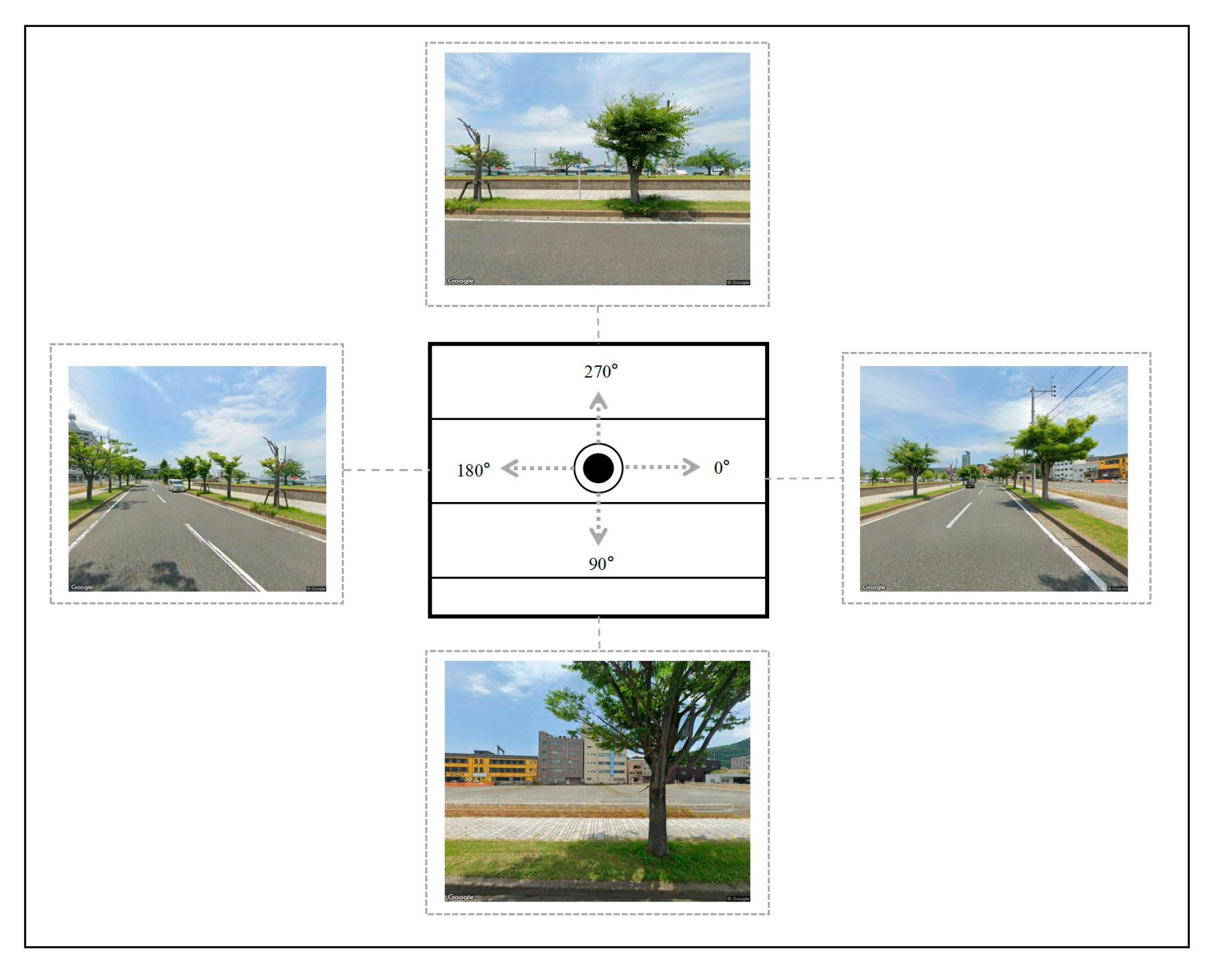
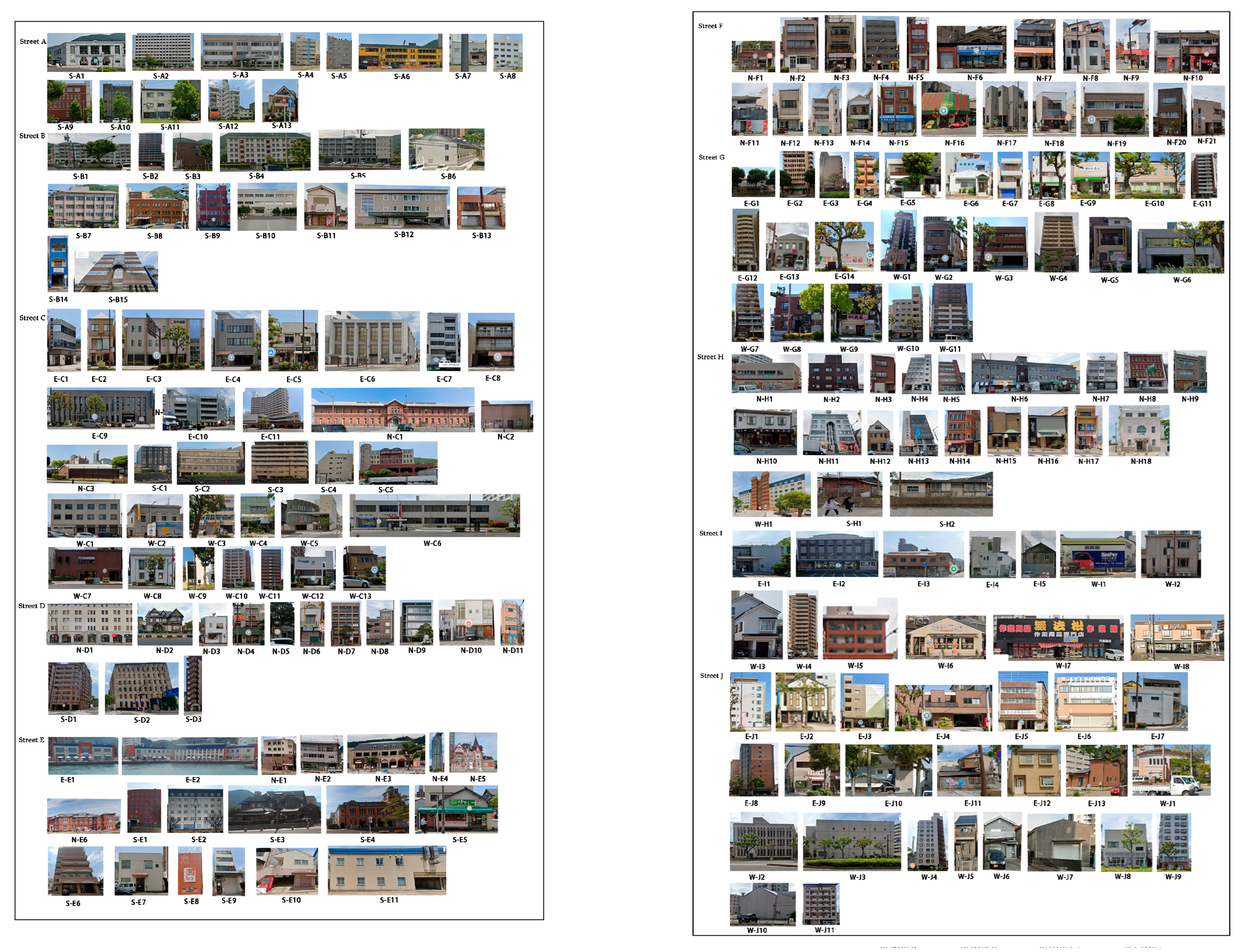
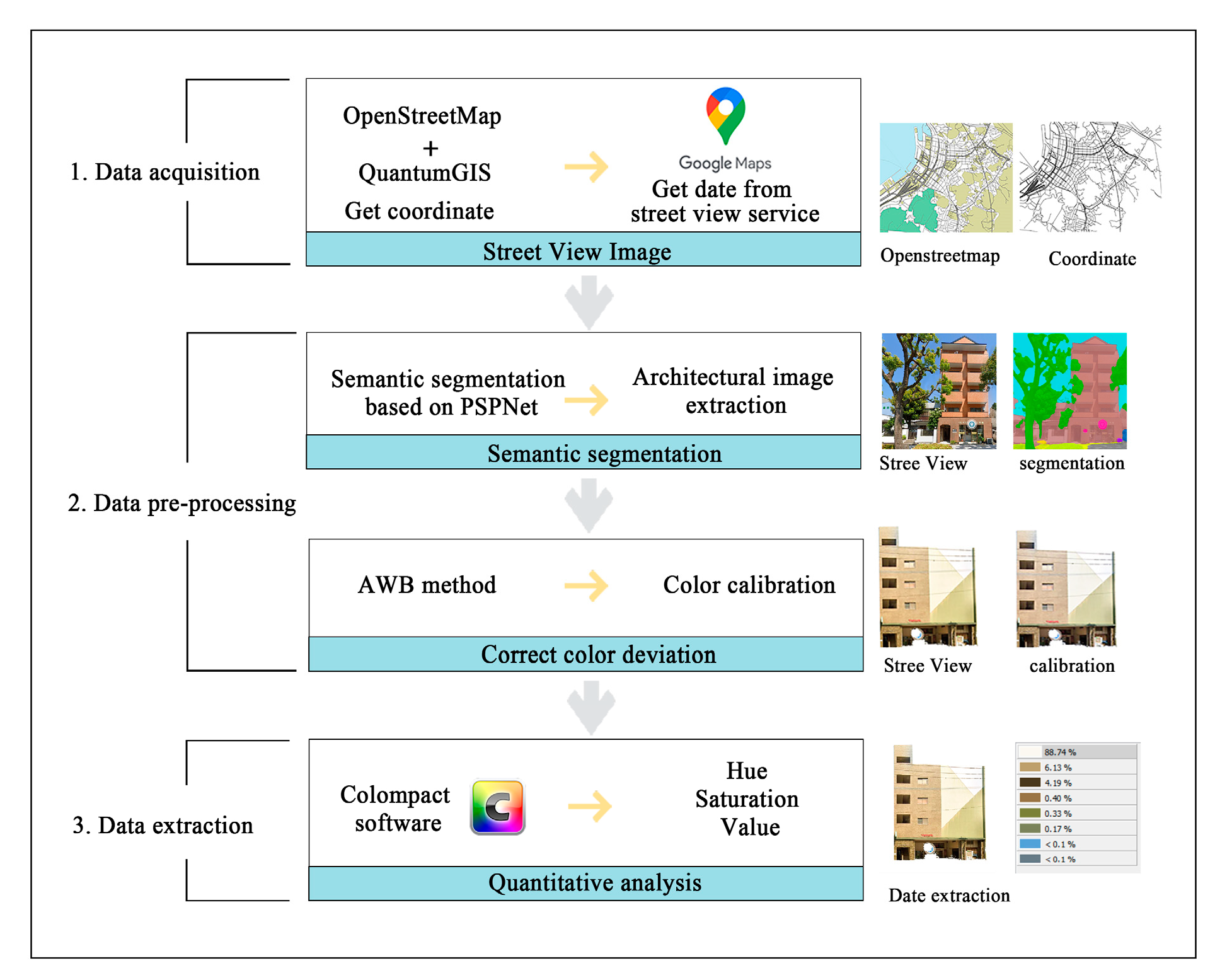
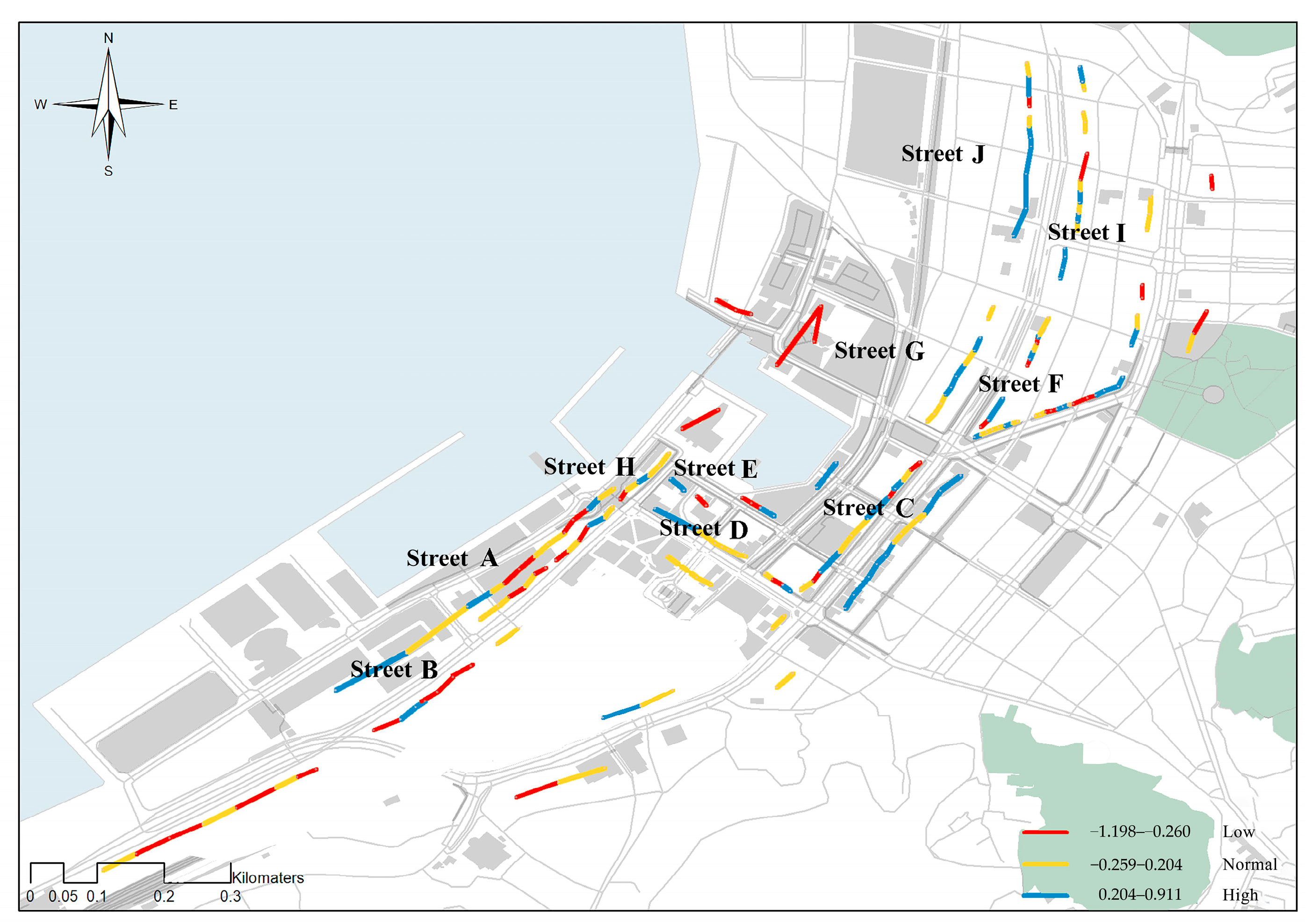
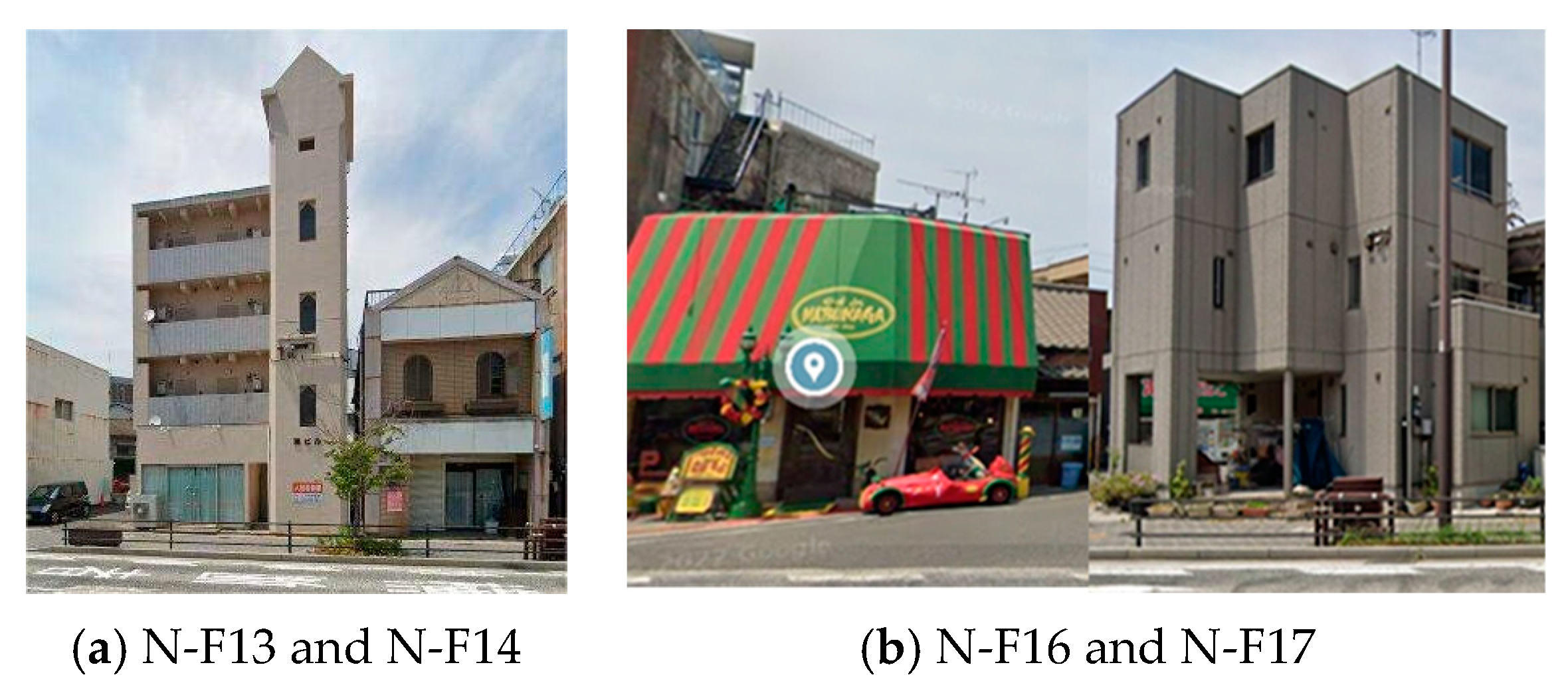
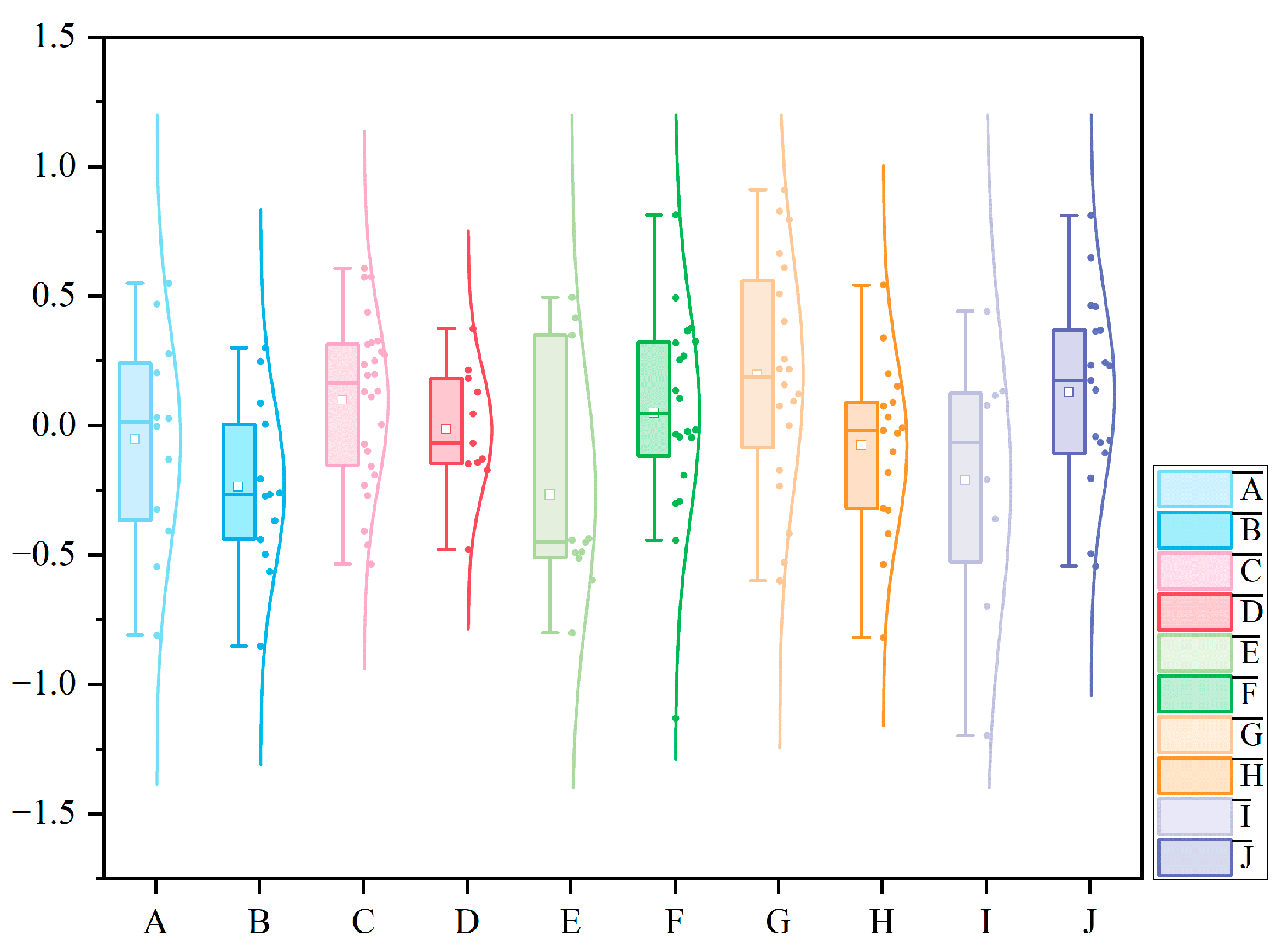
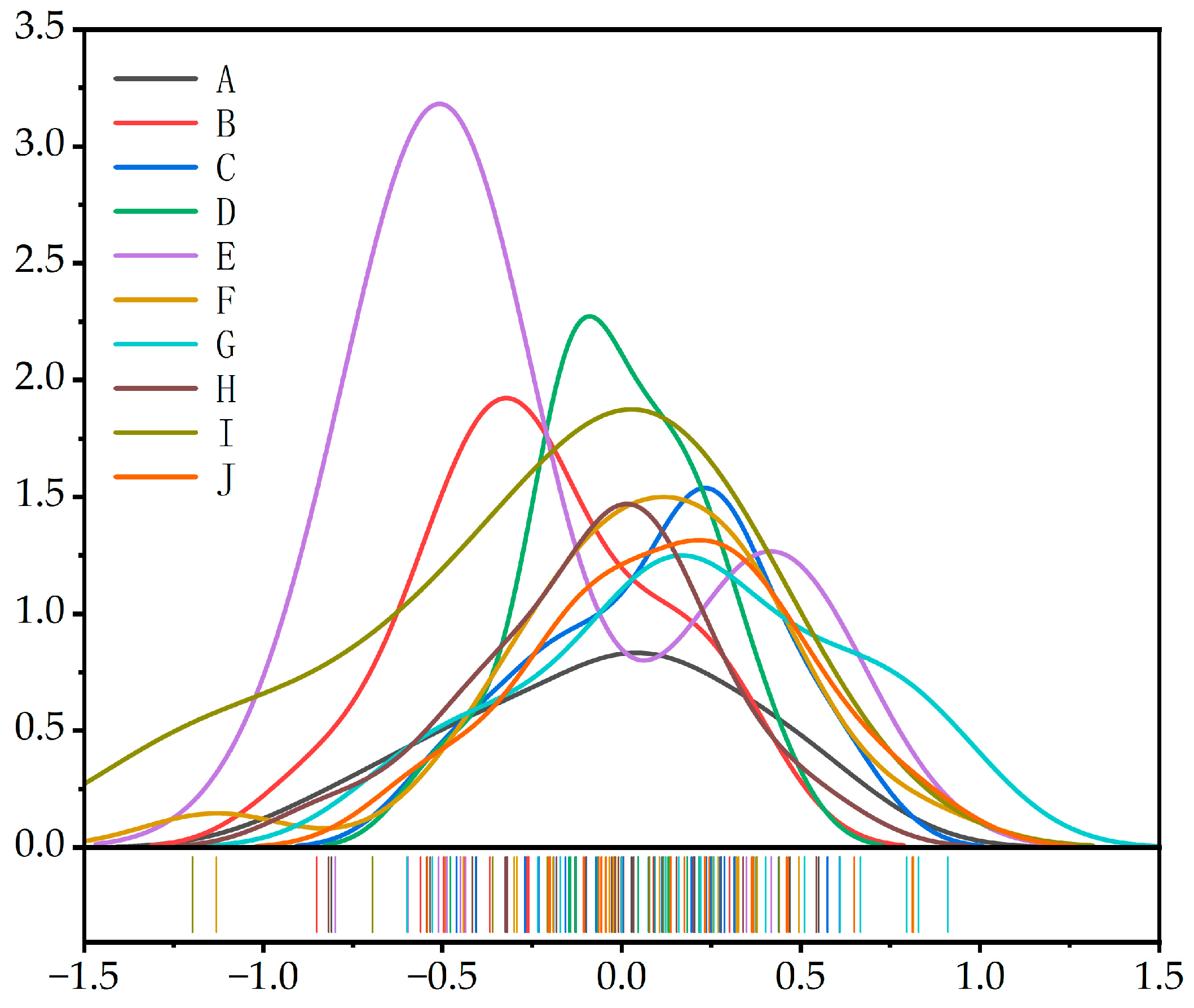

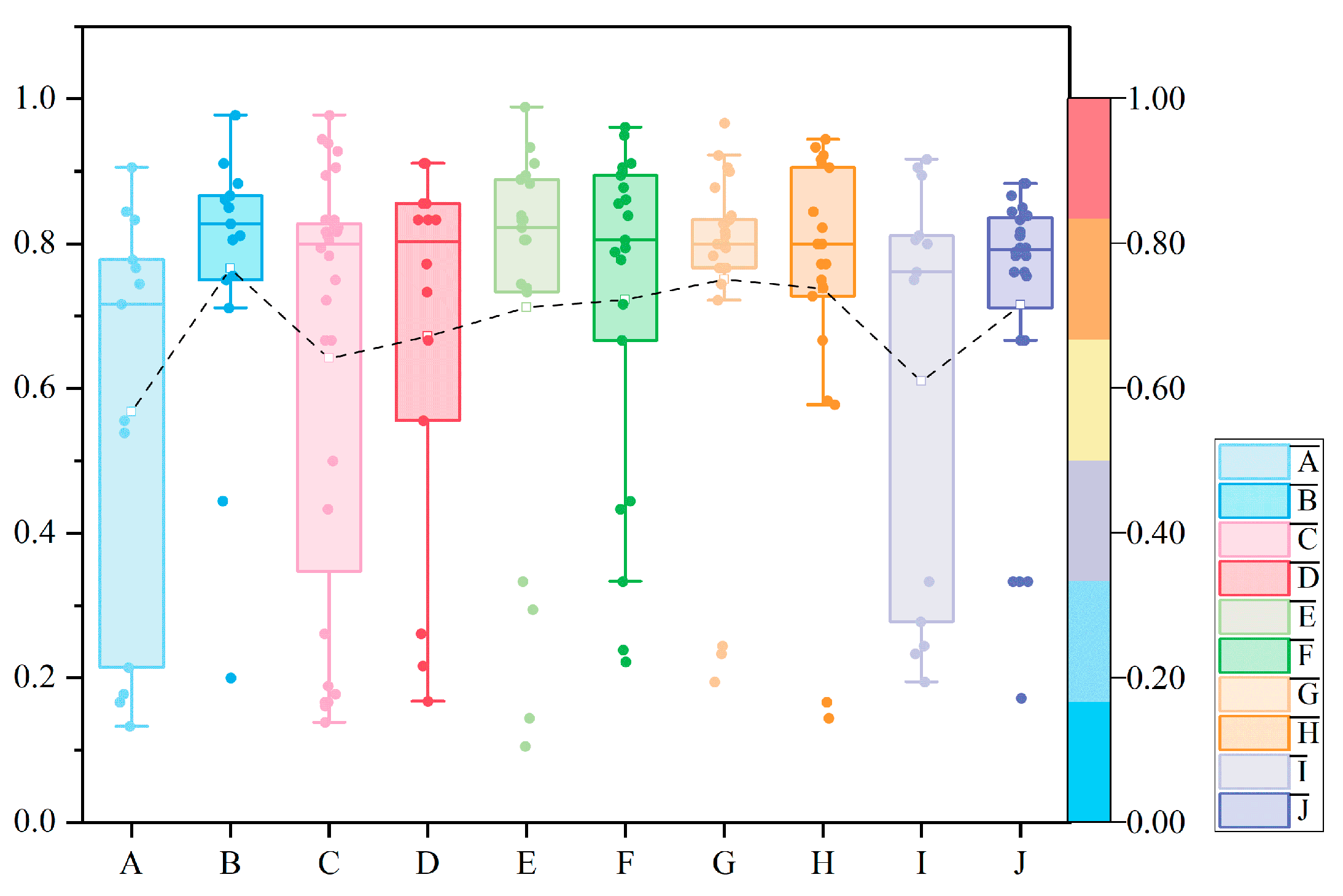

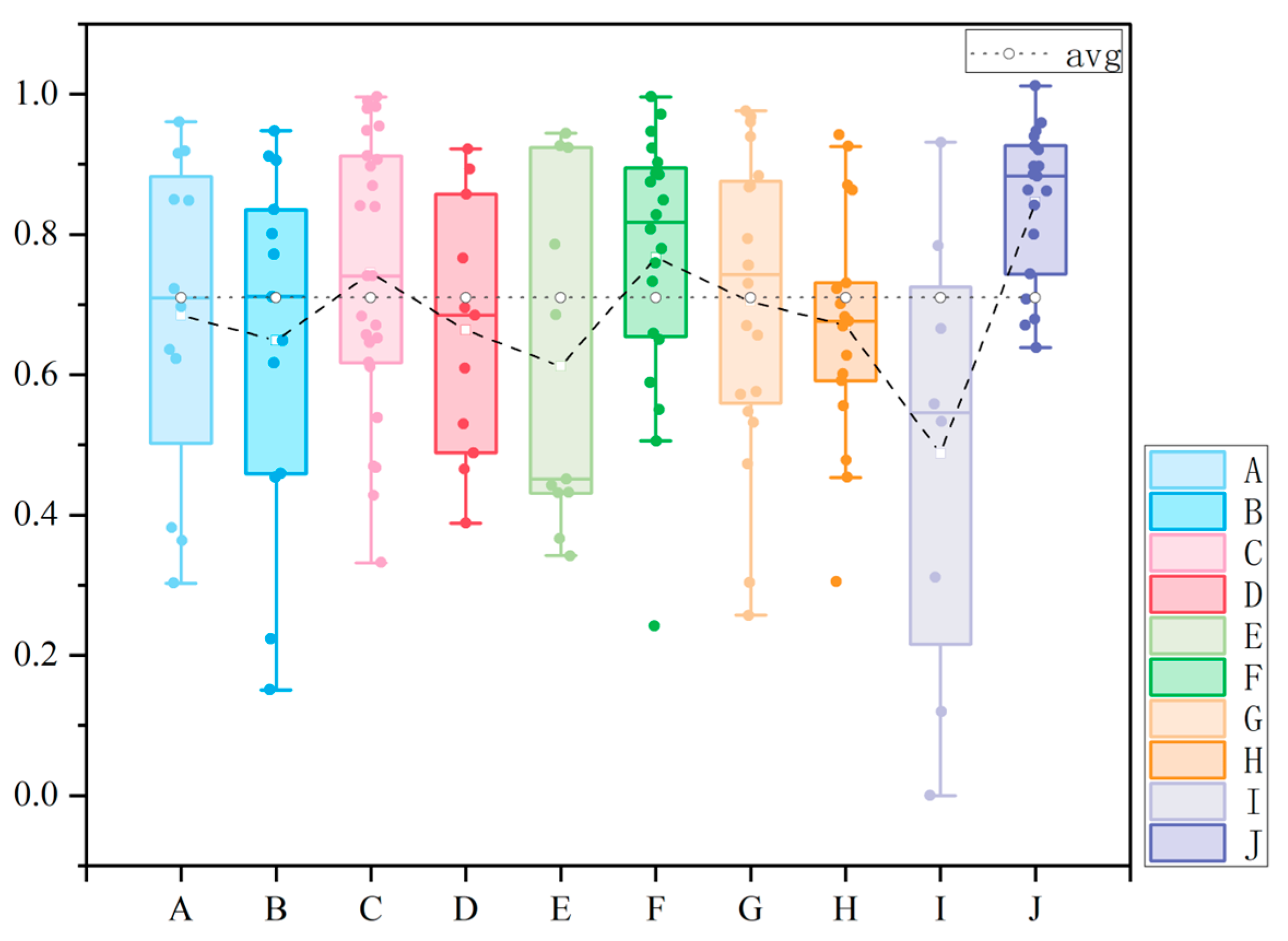
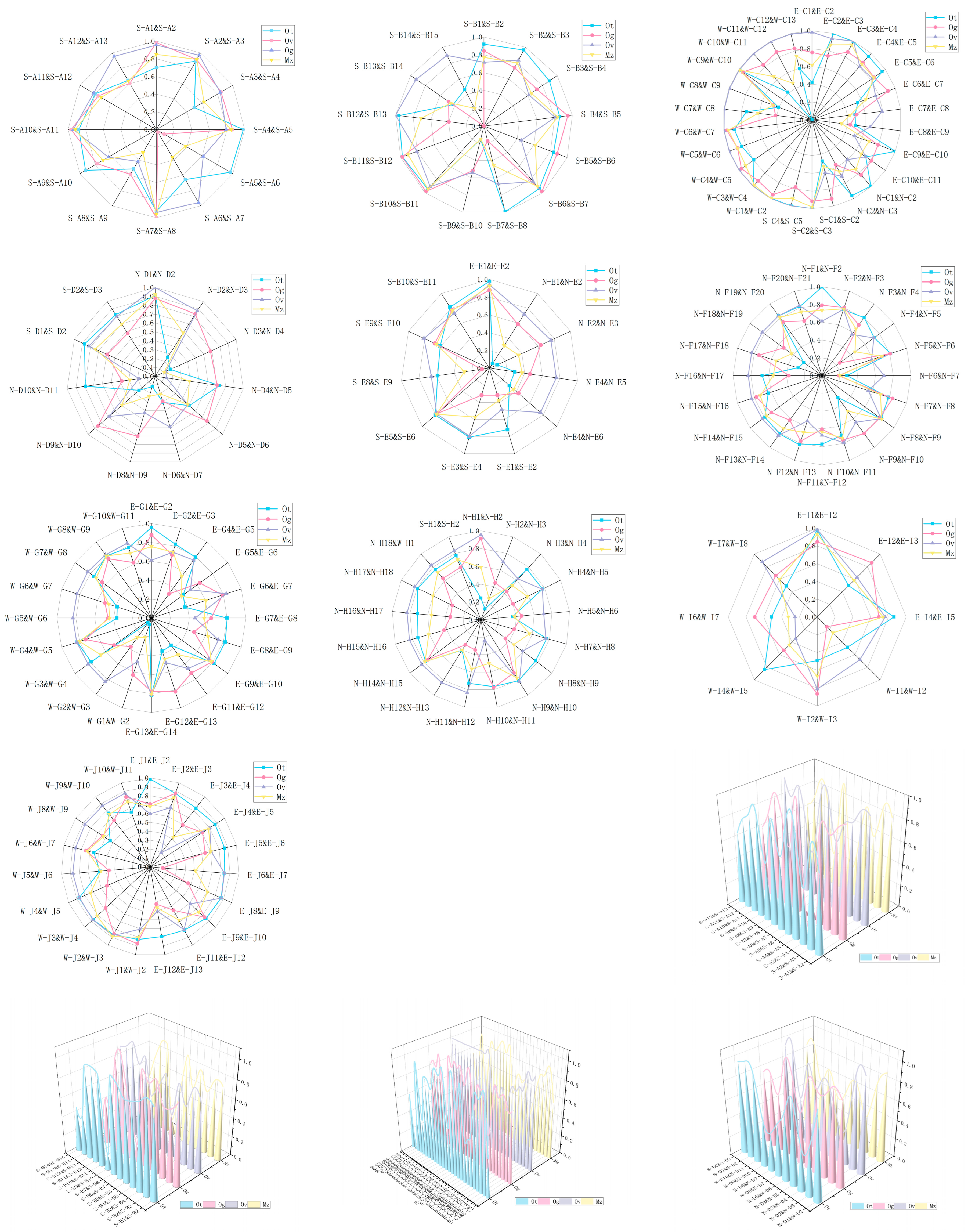
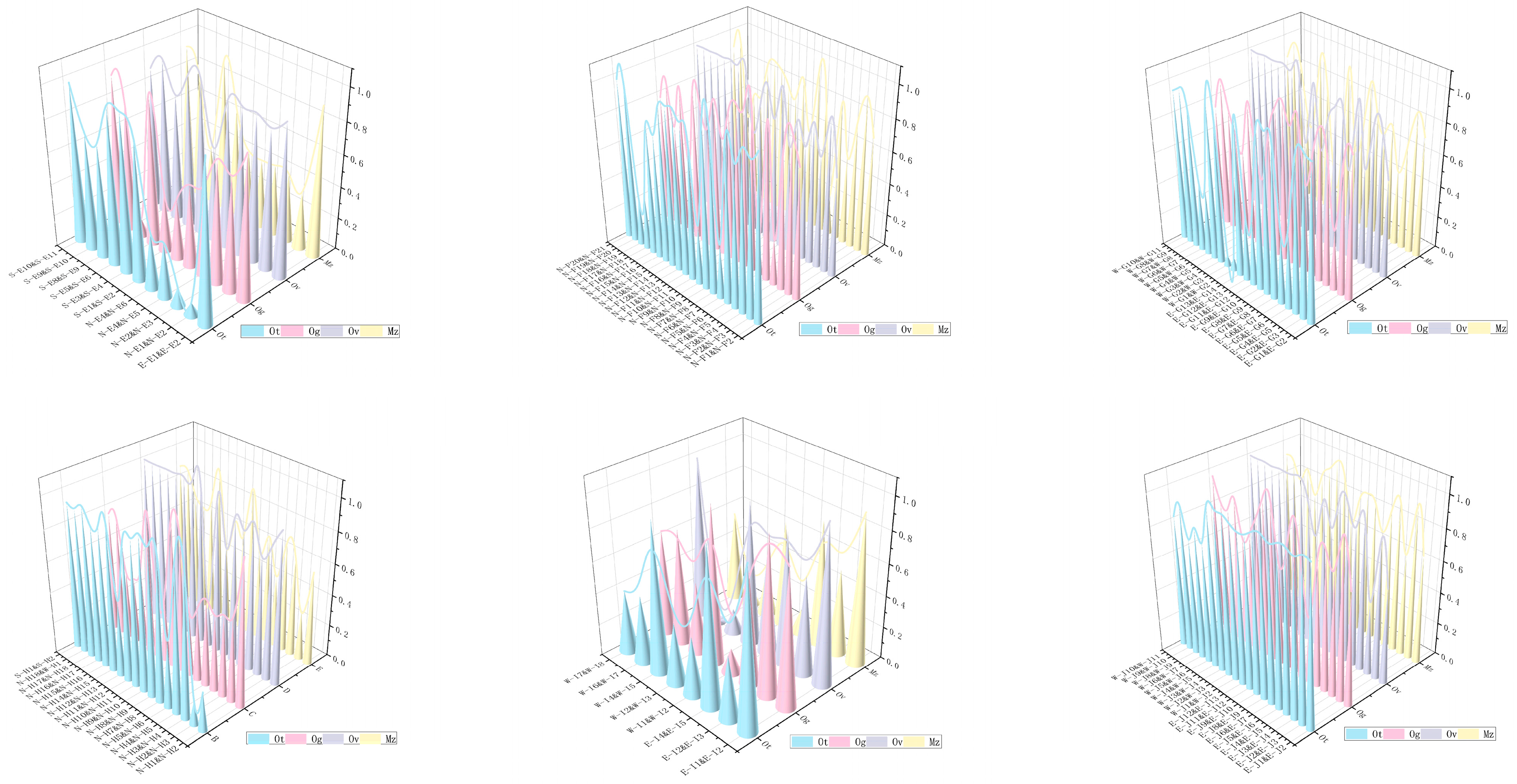
| Years | Institutions/Scholars | Theory |
|---|---|---|
| 1800 | Thomas Young | The three-color theory was proposed. The human eye can perceive three basic colors: red (R), green (G), and blue (B). This theory laid the foundation for later development. |
| Before 1924 | CIE | Study on the standard colorimetry system. |
| 1931 | W. DTright & J. Guild | The CIE1931 standard colorimetric observer spectral tristimulus values were specified, the CIE standard colorimetric system was constructed, and the CIE1931 chromaticity diagram was drawn. |
| 1950 | American National Standards Institute | The Munsell Color System, the first international standard color system, was founded. It divides color into three dimensions: hue, brightness, and purity, and provides an important basis for color standardization and application [16]. |
| 1964 | W.S.Stiles, J.M. Bruch & N. I. Speranskaya | The CIE1964 supplementary colorimetric system and the corresponding chromaticity diagram were developed, which were widely used in the world for the calculation of chroma and color differences. |
| 1964 | CIE | The concept of three-dimensional space of uniform color space was proposed [17]. |
| 1976 | CIE | CIE1976 was formulated, and a new color difference formula CIELAB was proposed. Publication of CIE standard light source. |
| Late 20th century | Color theories and models in digital image processing and computer graphics, such as RGB and CYK color models, provide an application platform for modern colorimetry. |
| Research Perspective | Scholars | Content | Country |
|---|---|---|---|
| Geography and Culturology | Jean-Philippe Lenclos | Different geographical environments affect the formation and development of race, nation, customs, culture, and so on. These factors lead to different color expressions. | France |
| Lois Swirnoff | The relationship between color selection and cultural characteristics. | United States | |
| Gareth Doherty | The relationship between color and geographical location, spatiality, and built urban environment. | United States | |
| Salman Hasanvand | The influence of color on urban space and the concept of readability. | United States | |
| Kazuki Yoshida | Studied the relationship between landscape method and color. The relationship between color and spatial form, the importance of color background, color relevance, andcolor attractiveness level in planning; the role of color harmony theory in landscape planning and landscape diversion; and the phenomenon of color clustering and segmentation caused by color similarity and similarity were studied theoretically. | Japan | |
| Kelvin John Lancaster | From the landscape level, it was proposed to display the color characteristics under the context. | United States | |
| Sociology | Krisztina Fehrvary | Color reflects the material culture associated with the political and economic system. | United States |
| Color and Environmental Science | Haroldting | The research involved building materials, historical buildings, and landscapes; light and environmental colors; color education; industrial colors; color formalism; environmental colors and light; color education; and research. | United States |
| Edtavere | The background of color formation of historical buildings, color protection, and meditation. | United Kingdom | |
| Color Psychology | Shigetoshi Kobayashi | The coordinate system of color image provides an effective method for studying color psychology and providing a color scheme in line with color psychology. | Japan |
| Title 1 | Title 3 |
|---|---|
| Street A | Dairen St |
| Street B | Nishikaigan St |
| Street C | Nat’l Rte 3 |
| Street D | Nat’l Rte 198 |
| Street E | Kyuosakashosen St, Gas to St, Retro Central St |
| Street F | Nat’l Rte 3 |
| Street G | 1 Hamamachi |
| Street H | Nat’l Rte 198 |
| Street I | Oimatsu Park St |
| Street J | Hamamachi 2 |
| Hue Statistics | |||||||||||
|---|---|---|---|---|---|---|---|---|---|---|---|
| H | R | YR | Y | GY | G | BG | B | PB | P | PR | N |
| number of samples | 33 | 96 | 4 | 3 | 0 | 0 | 18 | 3 | 2 | 2 | 36 |
| Percentage | 16.8 | 48.7 | 2.0 | 1.5 | 0 | 0 | 9.1 | 1.5 | 1.0 | 1.0 | 18.4 |
| Brightness statistics | |||||||||||
| V | low brightness 0 < V ≤ 0.3 | Medium brightness 0.3 < V ≤ 0.7 | high brightness 0.7 < V ≤ 1 | ||||||||
| number of samples | 58 | 101 | 38 | ||||||||
| Percentage | 29.4 | 51.3 | 19.3 | ||||||||
| Saturation statistics | |||||||||||
| C | low saturation 0 < C ≤ 0.3 | Medium saturation 0.3 < C ≤ 0.7 | high saturation 0.7 < C ≤ 1 | ||||||||
| number of samples | 143 | 45 | 9 | ||||||||
| Percentage | 72.6 | 22.8 | 4.6 | ||||||||
Disclaimer/Publisher’s Note: The statements, opinions and data contained in all publications are solely those of the individual author(s) and contributor(s) and not of MDPI and/or the editor(s). MDPI and/or the editor(s) disclaim responsibility for any injury to people or property resulting from any ideas, methods, instructions or products referred to in the content. |
© 2025 by the authors. Licensee MDPI, Basel, Switzerland. This article is an open access article distributed under the terms and conditions of the Creative Commons Attribution (CC BY) license (https://creativecommons.org/licenses/by/4.0/).
Share and Cite
Lyu, M.; Qu, G.; Shi, J.; Sun, D.; Tian, Y. A Method for Studying Building Color Harmony in Coastal Historic and Cultural Districts: A Case Study of Mojiko, Japan. Buildings 2025, 15, 1496. https://doi.org/10.3390/buildings15091496
Lyu M, Qu G, Shi J, Sun D, Tian Y. A Method for Studying Building Color Harmony in Coastal Historic and Cultural Districts: A Case Study of Mojiko, Japan. Buildings. 2025; 15(9):1496. https://doi.org/10.3390/buildings15091496
Chicago/Turabian StyleLyu, Mei, Ge Qu, Jiaxuan Shi, Dong Sun, and Yi Tian. 2025. "A Method for Studying Building Color Harmony in Coastal Historic and Cultural Districts: A Case Study of Mojiko, Japan" Buildings 15, no. 9: 1496. https://doi.org/10.3390/buildings15091496
APA StyleLyu, M., Qu, G., Shi, J., Sun, D., & Tian, Y. (2025). A Method for Studying Building Color Harmony in Coastal Historic and Cultural Districts: A Case Study of Mojiko, Japan. Buildings, 15(9), 1496. https://doi.org/10.3390/buildings15091496





